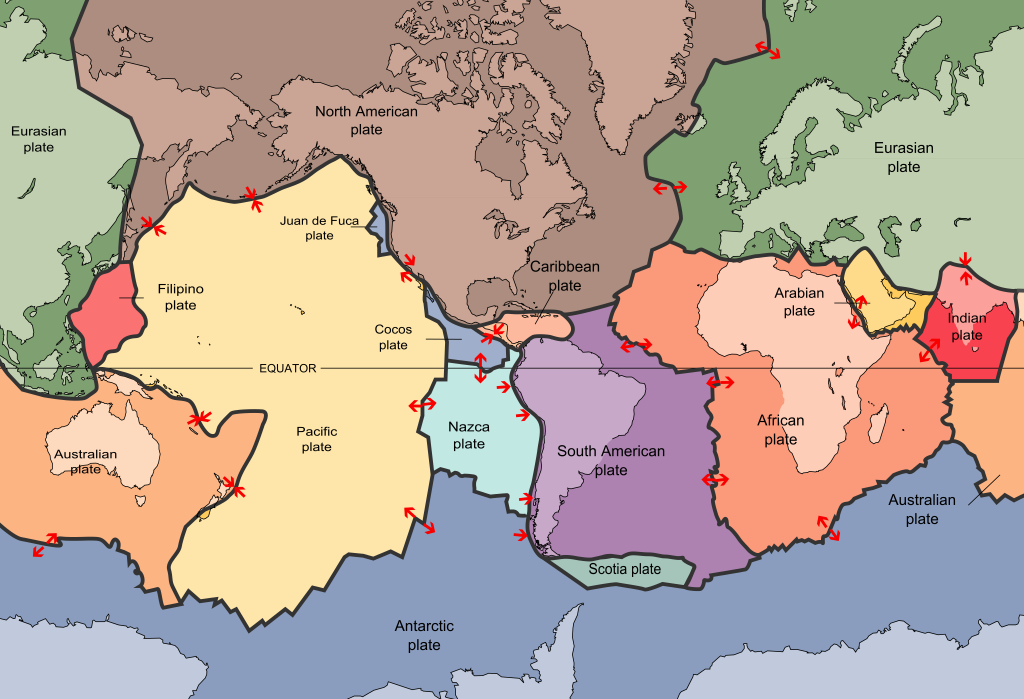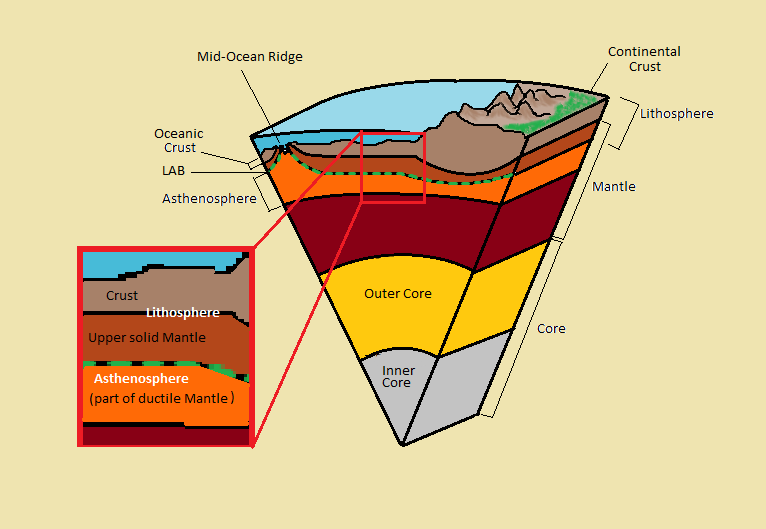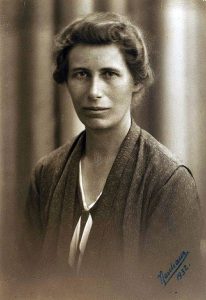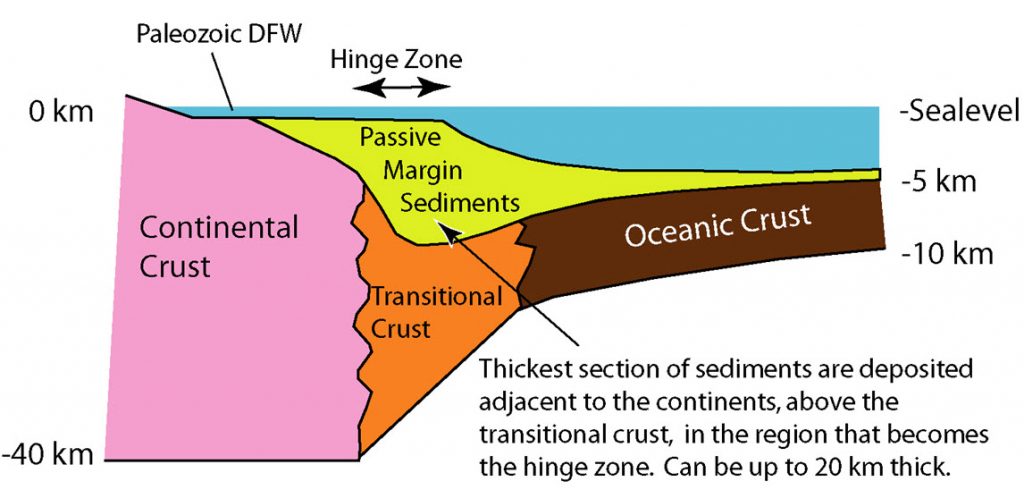2.2: Layers of the Earth
- Page ID
- 28216
\( \newcommand{\vecs}[1]{\overset { \scriptstyle \rightharpoonup} {\mathbf{#1}} } \)
\( \newcommand{\vecd}[1]{\overset{-\!-\!\rightharpoonup}{\vphantom{a}\smash {#1}}} \)
\( \newcommand{\id}{\mathrm{id}}\) \( \newcommand{\Span}{\mathrm{span}}\)
( \newcommand{\kernel}{\mathrm{null}\,}\) \( \newcommand{\range}{\mathrm{range}\,}\)
\( \newcommand{\RealPart}{\mathrm{Re}}\) \( \newcommand{\ImaginaryPart}{\mathrm{Im}}\)
\( \newcommand{\Argument}{\mathrm{Arg}}\) \( \newcommand{\norm}[1]{\| #1 \|}\)
\( \newcommand{\inner}[2]{\langle #1, #2 \rangle}\)
\( \newcommand{\Span}{\mathrm{span}}\)
\( \newcommand{\id}{\mathrm{id}}\)
\( \newcommand{\Span}{\mathrm{span}}\)
\( \newcommand{\kernel}{\mathrm{null}\,}\)
\( \newcommand{\range}{\mathrm{range}\,}\)
\( \newcommand{\RealPart}{\mathrm{Re}}\)
\( \newcommand{\ImaginaryPart}{\mathrm{Im}}\)
\( \newcommand{\Argument}{\mathrm{Arg}}\)
\( \newcommand{\norm}[1]{\| #1 \|}\)
\( \newcommand{\inner}[2]{\langle #1, #2 \rangle}\)
\( \newcommand{\Span}{\mathrm{span}}\) \( \newcommand{\AA}{\unicode[.8,0]{x212B}}\)
\( \newcommand{\vectorA}[1]{\vec{#1}} % arrow\)
\( \newcommand{\vectorAt}[1]{\vec{\text{#1}}} % arrow\)
\( \newcommand{\vectorB}[1]{\overset { \scriptstyle \rightharpoonup} {\mathbf{#1}} } \)
\( \newcommand{\vectorC}[1]{\textbf{#1}} \)
\( \newcommand{\vectorD}[1]{\overrightarrow{#1}} \)
\( \newcommand{\vectorDt}[1]{\overrightarrow{\text{#1}}} \)
\( \newcommand{\vectE}[1]{\overset{-\!-\!\rightharpoonup}{\vphantom{a}\smash{\mathbf {#1}}}} \)
\( \newcommand{\vecs}[1]{\overset { \scriptstyle \rightharpoonup} {\mathbf{#1}} } \)
\( \newcommand{\vecd}[1]{\overset{-\!-\!\rightharpoonup}{\vphantom{a}\smash {#1}}} \)
\(\newcommand{\avec}{\mathbf a}\) \(\newcommand{\bvec}{\mathbf b}\) \(\newcommand{\cvec}{\mathbf c}\) \(\newcommand{\dvec}{\mathbf d}\) \(\newcommand{\dtil}{\widetilde{\mathbf d}}\) \(\newcommand{\evec}{\mathbf e}\) \(\newcommand{\fvec}{\mathbf f}\) \(\newcommand{\nvec}{\mathbf n}\) \(\newcommand{\pvec}{\mathbf p}\) \(\newcommand{\qvec}{\mathbf q}\) \(\newcommand{\svec}{\mathbf s}\) \(\newcommand{\tvec}{\mathbf t}\) \(\newcommand{\uvec}{\mathbf u}\) \(\newcommand{\vvec}{\mathbf v}\) \(\newcommand{\wvec}{\mathbf w}\) \(\newcommand{\xvec}{\mathbf x}\) \(\newcommand{\yvec}{\mathbf y}\) \(\newcommand{\zvec}{\mathbf z}\) \(\newcommand{\rvec}{\mathbf r}\) \(\newcommand{\mvec}{\mathbf m}\) \(\newcommand{\zerovec}{\mathbf 0}\) \(\newcommand{\onevec}{\mathbf 1}\) \(\newcommand{\real}{\mathbb R}\) \(\newcommand{\twovec}[2]{\left[\begin{array}{r}#1 \\ #2 \end{array}\right]}\) \(\newcommand{\ctwovec}[2]{\left[\begin{array}{c}#1 \\ #2 \end{array}\right]}\) \(\newcommand{\threevec}[3]{\left[\begin{array}{r}#1 \\ #2 \\ #3 \end{array}\right]}\) \(\newcommand{\cthreevec}[3]{\left[\begin{array}{c}#1 \\ #2 \\ #3 \end{array}\right]}\) \(\newcommand{\fourvec}[4]{\left[\begin{array}{r}#1 \\ #2 \\ #3 \\ #4 \end{array}\right]}\) \(\newcommand{\cfourvec}[4]{\left[\begin{array}{c}#1 \\ #2 \\ #3 \\ #4 \end{array}\right]}\) \(\newcommand{\fivevec}[5]{\left[\begin{array}{r}#1 \\ #2 \\ #3 \\ #4 \\ #5 \\ \end{array}\right]}\) \(\newcommand{\cfivevec}[5]{\left[\begin{array}{c}#1 \\ #2 \\ #3 \\ #4 \\ #5 \\ \end{array}\right]}\) \(\newcommand{\mattwo}[4]{\left[\begin{array}{rr}#1 \amp #2 \\ #3 \amp #4 \\ \end{array}\right]}\) \(\newcommand{\laspan}[1]{\text{Span}\{#1\}}\) \(\newcommand{\bcal}{\cal B}\) \(\newcommand{\ccal}{\cal C}\) \(\newcommand{\scal}{\cal S}\) \(\newcommand{\wcal}{\cal W}\) \(\newcommand{\ecal}{\cal E}\) \(\newcommand{\coords}[2]{\left\{#1\right\}_{#2}}\) \(\newcommand{\gray}[1]{\color{gray}{#1}}\) \(\newcommand{\lgray}[1]{\color{lightgray}{#1}}\) \(\newcommand{\rank}{\operatorname{rank}}\) \(\newcommand{\row}{\text{Row}}\) \(\newcommand{\col}{\text{Col}}\) \(\renewcommand{\row}{\text{Row}}\) \(\newcommand{\nul}{\text{Nul}}\) \(\newcommand{\var}{\text{Var}}\) \(\newcommand{\corr}{\text{corr}}\) \(\newcommand{\len}[1]{\left|#1\right|}\) \(\newcommand{\bbar}{\overline{\bvec}}\) \(\newcommand{\bhat}{\widehat{\bvec}}\) \(\newcommand{\bperp}{\bvec^\perp}\) \(\newcommand{\xhat}{\widehat{\xvec}}\) \(\newcommand{\vhat}{\widehat{\vvec}}\) \(\newcommand{\uhat}{\widehat{\uvec}}\) \(\newcommand{\what}{\widehat{\wvec}}\) \(\newcommand{\Sighat}{\widehat{\Sigma}}\) \(\newcommand{\lt}{<}\) \(\newcommand{\gt}{>}\) \(\newcommand{\amp}{&}\) \(\definecolor{fillinmathshade}{gray}{0.9}\)In order to understand the details of plate tectonics, it is essential to first understand the layers of the earth. In general, the Earth can be divided into layers based on chemical composition and physical characteristics.

Chemical Composition Layers
Certainly, the earth is composed of countless combinations of elements. Regardless of what elements are involved two major factors—temperature and pressure—are responsible for creating three layers have distinct chemical compositions.
Crust
The outermost chemical layer and the one we walk on is the crust. Its composition is such that it has the highest amounts of silicon and oxygen of any of the layers. Since there is so much silicon and oxygen there is not much room for other element, most importantly iron or magnesium. There are two types of crust. Continental crust is thick has a relatively low density (is lighter). Oceanic crust is thin and has a relatively high density (is heavier), especially when cold and old. The surface levels of crust are relatively brittle which means they behave like solid glass or pottery and break under force. The deeper parts of the crust are subjected to higher temperatures and pressure, which makes them more ductile which means they behave like soft plastics or putty, and move under force.

The base of the crust is characterized by a large increase in seismic velocity, which measures how fast earthquake waves travel through solid matter. Called the Mohorovičić Discontinuity, or Moho for short, this zone was discovered by Andrija Mohorovičić (pronounced mo-ho-ro-vee-cheech) in 1909 after studying earthquake wave paths in his native Croatia [27]. The change in wave direction and speed is caused by dramatic chemical differences between the crust and next layer (the mantle) and showed that the earth was not the same substance all the way through!
Mantle

The mantle sits below the crust. It is the largest chemical layer by volume, extending from the base of the crust to a depth of about 2900 km [29]. Most of what we know about the mantle comes from seismic wave analysis, though the information is gathered by studying ophiolites and xenoliths. Ophiolites are pieces of the mantle that have risen through the crust until they are exposed as part of the ocean floor. Xenoliths are carried within magma and brought to the Earth’s surface by volcanic eruptions. Most xenoliths are made of peridotite, an very iron-rich igneous rock we will learn about in Chapter 4. Because of this, scientists hypothesize most of the mantle is made of peridotite which is much lower in silicon and oxygen, and much higher in iron and magnesium [30].
Core

Below the mantle, at the center of the earth is the core. The core, has both liquid and solid layers, and consists mostly mostly metallic iron [33]. Scientists looking at seismic data first discovered this innermost chemical layer in 1906 [32].
Physical Layers
The Earth can also be broken down into five distinct physical layers based on how each layer responds to stress. While there is some overlap in the chemical and physical designations of layers, specifically the core-mantle boundary, there are significant differences between the two systems.
Lithosphere

Lithos is Greek for stone, and the lithosphere is the outermost physical layer of the Earth made up of the crust and solid upper mantle. It is grouped into two types: oceanic and continental. Oceanic lithosphere is thin and relatively rigid. Continental lithosphere is generally thicker and considerably more plastic, especially at the deeper levels. The lithosphere is not continuous. It is broken into segments called plates. A plate boundary is where two plates meet and move relative to each other. Plate boundaries are where we see plate tectonics in action—mountain building, triggering earthquakes, and generating volcanic activity. Some plates are made up of only oceanic lithosphere but most have a combination of both types.
Asthenosphere

The asthenosphere is the layer below the lithosphere. Astheno- means lacking strength, and the most distinctive property of the asthenosphere is movement. Because it is mechanically weak, this layer moves and flows due to convection currents created by heat coming from the earth’s core [33].
Mesosphere
![By Cadmium at English Wikipedia (Transferred from en.Wikipedia to Commons.) [Public domain], <a data-cke-saved-href="https://commons.wikimedia.org/wiki/File%3APerovskite.jpg" href="https://commons.wikimedia.org/wiki/File%3APerovskite.jpg" The atoms are arranged.](http://opengeology.org/textbook/wp-content/uploads/2016/07/Perovskite-300x288.jpg)
The mesosphere, sometimes known as the lower mantle, is more rigid and immobile than the asthenosphere. Located at a depth of approximately 410 and 660 km below the earth’s surface, the mesosphere is subjected to very high pressures and temperatures.
Inner and Outer Core

The outer core is the only entirely liquid layer within the Earth. In 1936, the Danish geophysicist Inge Lehmann analyzed seismic data and was the first to prove a solid inner core existed within a liquid outer core [39]. The solid inner core is about 1,220 km thick, and the outer core is about 2,300 km thick [40].
It seems like a contradiction that the hottest part of the Earth is solid, as the minerals making up the core should be liquified or vaporized at this temperature. Immense pressure keeps the minerals of the inner core in a solid phase [41].

The earth’s liquid outer core is critically important in maintaining a breathable atmosphere and other environmental conditions favorable for life. Scientists believe the earth’s magnetic field is generated by the circulation of molten iron and nickel within the outer core [43]. If the outer core were to stop circulating or become solid, the loss of the magnetic field would result in Earth getting stripped of life-supporting gases and water.
Plate Tectonic Boundaries

At passive margins, there is no plate boundary—the continental lithosphere transitions into the oceanic lithosphere and forms plates made of both types. North and South America’s eastern coastlines are examples of passive margins. Active margins are places where the oceanic and continental lithospheric tectonic plates meet and move relative to each other, such as the western coasts of North and South America. The majority of mountain-building events, earthquake activity and active volcanism on the Earth’s surface can be attributed to tectonic plate movement at active margins, where two plates meet.
![By Jose F. Vigil. USGS ([1]) [Public domain], <a data-cke-saved-href="https://commons.wikimedia.org/wiki/File%3ATectonic_plate_boundaries.png" href="https://commons.wikimedia.org/wiki/File%3ATectonic_plate_boundaries.png" It shows all the types](http://opengeology.org/textbook/wp-content/uploads/2016/07/Tectonic_plate_boundaries.png)
In a simplified model, there are three categories of tectonic plate boundaries. Convergent boundaries are places where plates move toward each other. At divergent boundaries, the plates move apart. At transform boundaries, the plates slide past each other.
References
- 27. Herak, D. & Herak, M. Andrija Mohorovičić (1857-1936)—On the occasion of the 150th anniversary of his birth. Seismol. Res. Lett. 78, 671–674 (2007).
- 29. Birch, F. Elasticity and constitution of the Earth’s interior. J. Geophys. Res. 57, 227–286 (1952).
- 30. Wyllie, P. J. Ultramafic rocks and the upper mantle. in Fiftieth anniversary symposia: Mineralogy and petrology of the Upper Mantle; Sulfides; Mineralogy and geochemistry of non-marine evaporites (ed. Morgan, B. A.) 3–32 (Mineralogical Society of America, 1970).
- 32. Oldham, R. D. The constitution of the interior of the Earth, as revealed by earthquakes. Q. J. Geol. Soc. London 62, 456–475 (1906).
- 33. Birch, F. Density and composition of mantle and core. J. Geophys. Res. 69, 4377–4388 (1964).
- 39. Lehmann, I. P’, Publ. Bur. Centr. Seism. Internat. Serie A 14, 87–115 (1936).
- 40. Engdahl, E. R., Flynn, E. A. & Masse, R. P. Differential PkiKP travel times and the radius of the core. Geophysical J Royal Astro Soc 40, 457–463 (1974).
- 41. Aitta, A. Iron melting curve with a tricritical point. J. Stat. Mech. 2006, P12015 (2006).
- 42. Waszek, L., Irving, J. & Deuss, A. Reconciling the hemispherical structure of Earth/’s inner core with its super-rotation. Nat. Geosci. 4, 264–267 (2011).
- 43. de Wijs, G. A. et al. The viscosity of liquid iron at the physical conditions of the Earth’s core. Nature 392, 805–807 (1998).


